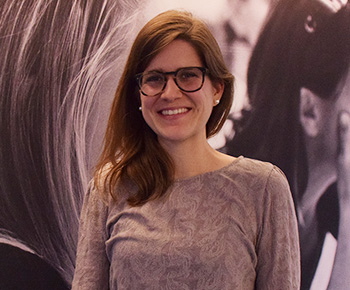
Teresa Walch
For a historian, using a top-down approach is standard – you use government records, archives of primary and secondary sources to fulfill your research; you undress the documents and make sure they stand up, factually, and you stop there. But a bottom-up approach can provide a more complete image of an event, allowing those who lived through the time a voice in history.
Teresa Walch, Ph.D. candidate in modern European history at UC San Diego and recipient of USC Shoah Foundation Center for Advanced Genocide Research’s inaugural Robert J. Katz Research Fellowship in Genocide Studies, hopes to use the latter approach during her month at the Institute as she works on her dissertation about Jewish spaces in Holocaust-era Germany.
“Obviously I have a lot of governmental records, a lot of top-down views right now,” Walch said. “I know the laws that occurred, but I’m looking for the voices. I want to know what this experience was like for Jews as they became strangers, in a sense, in their homeland.”
Halfway through her dissertation research with a Fulbright fellowship in Germany, Walch found that what was lacking in her research was personal accounts from Jews who lived in Germany during the 1930s and early 1940s. While she had plenty of invaluable documents from local archives in Berlin – of notes from governmental offices, Nazi party organizations and Gestapo – a critical dimension was missing from her work: testimony.
“I’m hoping to provide this personal voice, this view from the ground-up [by using testimony],” Walch said. “As historians, we often have this idea that the only valuable source or objective sources are those that come from archives. But, of course, those documents as well have inherent biases and subjectivities from the people who wrote them. So for me, as a historian, it’s important to also try to bring these voices from below, that aren’t just from a fascist, racist regime, but what the experience was like for the people.”
After spending a year volunteering at the Dachau concentration camp memorial site with the German organization Action Reconciliation Services for Peace, Walch came to realize the value of testimony when she started working with the biographies of former prisoners and survivors at the camp. And when the organization would connect local school groups with survivors, Walch would attend the talks and seminars.
“I got to meet them – mostly ones who lived around Munich – and then in grad school in San Diego, I was a grader for several undergraduate Holocaust courses,” Walch said. “One of the professors there utilized testimonies [from the Visual History Archive] in her class.”
Seeing this and seeing the effect survivors’ testimonies had on her students, Walch understood what could be achieved with testimony, and the value of studying it while we still can.
“As time goes on, we’re losing the ability to be able to speak to survivors,” Walch said. “I think they’re fantastic resources and it really brought the history to a personal level for these students, in a way they hadn’t encountered before.”
With her month as a fellow at USC Shoah Foundation, Walch has been searching for testimony to support her dissertation, which explores the exclusion of German Jews from their own homeland during the Holocaust and discusses how space played a crucial role in the Nazi rise to and consolidation of power, through prisons, concentration camps and Nazis’ barring of Jews from all public spaces like stores, restaurants, sidewalks and ultimately, their own homes.
“I’m working on finding information for a couple chapters of my dissertation that specifically look at Jewish spaces in Germany broadly, specifically in Berlin as my main case study,” Walch said. “I’m looking at how Jewish spaces – anything from sites of worship, synagogues, to hospitals, homes, stores – were targeted in violent acts of destruction from 1933 through the end of the war.”
Her other focus is on the local ordinances developed against Jews, and on the interplay between things German citizens were doing themselves and the national laws that worked to systematically exclude Jews from spaces.
One challenge Walch has encountered while researching using the vast Visual History Archive has been in feeding the right search terms into the archive to find that data and stories she’s looking for. So far, she’s found success in narrowing her search by looking for testimony from specific cities, and when that doesn’t work, working with what she has found has been just as rewarding.
“It may sound cliche, but really it’s an amazing experience to hear those stories,” Walch said. “I find myself laughing when they tell a joke, or really feeling their stories when they get emotional as well. Also, to be at a center here at USC Shoah Foundation – it’s amazing, the resources I have and the connections I can make. It’s really a fantastic place for me as a young historian to be.”
The Robert J. Katz Research Fellowship in Genocide Studies is enables an advanced-standing Ph.D. candidate to spend up to a month in residence at USC Shoah Foundation each year. The fellowship, which provides $4,000 in support for dissertation research, is named for long-time volunteer and former Board of Councilors Chair Robert J. Katz, in recognition of his service to the Institute.